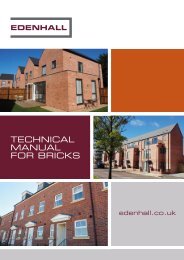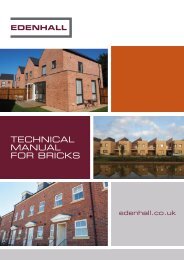Create successful ePaper yourself
Turn your PDF publications into a flip-book with our unique Google optimized e-Paper software.
3. ABOUT EDENHALL BRICKS<br />
3.1 The Manufacturing Process<br />
The process for manufacturing <strong>Edenhall</strong> bricks is efficient and flexible allowing adjustments to production plans to be<br />
made quickly and easily in response to market demands.<br />
Production involves the compaction of a semi-dry mix of graded aggregates, cementitious material, water, pigments<br />
and additives. During the mixing process various combinations of pigments and additives can be introduced depending<br />
on the particular brick that is required. The whole process is computer controlled to ensure that replication of the recipe<br />
can be maintained for future requirements. Secondary treatments for texture and colour can be applied to the brick as<br />
and when required.<br />
The resultant “green” or uncured bricks are transferred to chambers where the exothermic reaction of the cement<br />
increases the temperature and humidity so that the product cures naturally. Minimal additional heat is required, thus<br />
CO 2 emissions are significantly reduced. Once the bricks are cured in the chambers they are packaged and<br />
shrink-wrapped and left to further cure in the stockyard until they are required on site.<br />
3.2 The Benefits of <strong>Edenhall</strong> Bricks<br />
• The aggregate raw materials are generally sourced locally and are often classed as a by-product of primary, clean<br />
graded aggregates.<br />
• Cements are generally sourced from UK production facilities and are supplemented by environmentally beneficial<br />
replacements with pozzolanic properties.<br />
• The amount of water used in production is extremely low and can come from recycled sources.<br />
• Facing bricks can be made to prescribed mixes which can be replicated at different <strong>Edenhall</strong> factories, thus<br />
reducing distribution costs.<br />
• <strong>Edenhall</strong> bricks will continue to age harden throughout their life cycle. They have virtually no soluble salts and can<br />
be crushed and recycled at the end of their life.<br />
• <strong>Edenhall</strong> bricks have low cement content, aided by the pozzolanic characteristics of the fine aggregate, thus<br />
minimising the carbon footprint whilst maintaining their strength and durability properties.<br />
• The composition of the bricks means they are fire resistant, have an A+ rating, and their density can offer<br />
enhanced levels of sound reduction in flanking walls or lightweight structures.<br />
• <strong>Edenhall</strong>’s factories are strategically placed throughout the country thus enabling us to minimise our transport<br />
mileage which in turn reduces our carbon footprint. We do not need to import bricks to support demand.<br />
• The embodied and emitted carbon content is low and they are a net absorber of CO 2. <strong>Edenhall</strong> bricks typically will<br />
have







